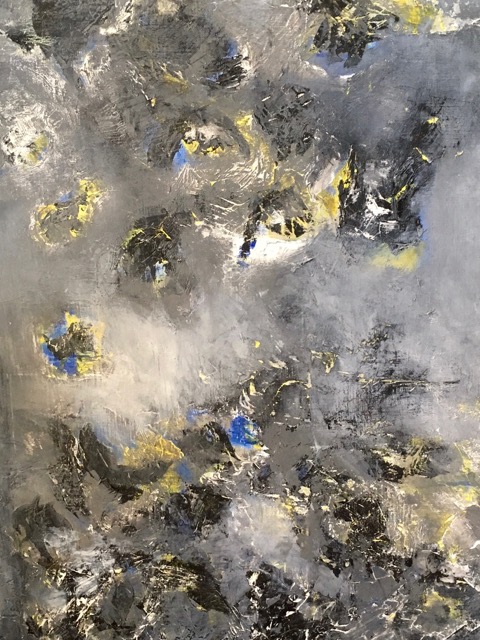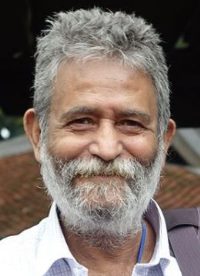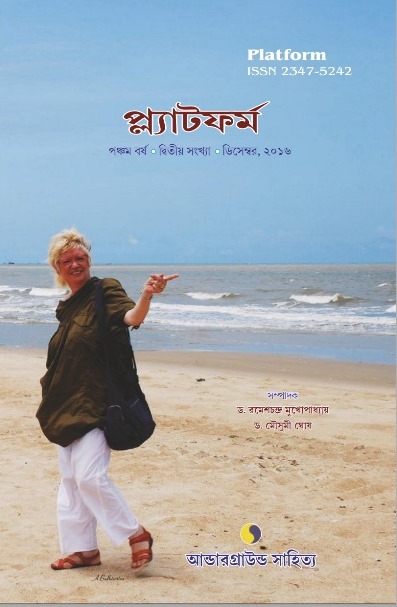Silence (28) - Mai Văn Phấn. Explication par Dr. Ramesh Chandra Mukhopadhyaya. Traduction française Dominique de Miscault
Explication par Dr. Ramesh Chandra Mukhopadhyaya
Traduction française Dominique de Miscault

Photo: Dominique de Miscault
Silence
28
Au crépuscule
ou à l'aube
un albatros
sur le piquet d’une barrière
de loin, il est noir
découpage
ou statue de pierre
La mer calme est brune
concentré
j’avance sur l'eau
sans laisser de traces
Derrière moi
plus d’oiseau.
Explication
Il s’agit là, d’un moment : L'aube ou le crépuscule. Un moment de la journée où les contraires se mêlent. Une heure où les opposés se confondent, une se produit une grande émission d'énergie. Soudain, un albatros atterrit sur le piquet d’une barrière. L'albatros, ce grand oiseau de mer, également associé au soleil. Les marins croient que les marins noyés vont retrouver un albatros. L'albatros est un oiseau libre qui ose des routes inexplorées sur mers comme sur terre. Il ne recule devant aucun obstacle. Curieusement, il atterrit sur un piquet (ou pike en anglais) de barrière. (Pike en anglais) Le brochet, lui, est un grand poisson prédateur. La scène se passe au bord de la mer où se tient le poète. Il aperçoit peut-être un brochet qui lui semble être une barrière sur la mer. Bien sûr, il doit s'agir d'une mer calme. Elle est brune et calme. Le brun est la couleur de la terre qui parle de fiabilité et de stabilité. Là, le brochet ressemble à une lance aux dents acérées, sans doute, au crépuscule. L'albatros se pose sur un brochet. C'est un spectacle extraordinaire. Les forces du ciel se mêlent aux forces de l'eau et de la terre. Le moment où le poète témoigne de ce spectacle unique est également propice. Parce que les forces de la nuit et du jour, la lumière et l'obscurité sont confondues. L'albatros sur le brochet est à distance du poète. Le crépuscule transforme tout. Le crépuscule et la distance modifient tout. C’est le grand mélange de deux forces primordiales du ciel et l'eau dans une image fixe – une image de papier découpé ou une statue de pierre qui rappellerait un Tangkha. Il parle de la géométrie de Mandelbrot et de mathématiques floues. Ce qui peut être considéré comme vivant et dynamique à proximité est fixe à distance. Ce qui pourrait être considéré comme vivant et dynamique pourrait ressembler à une statue au lointain. Ce n'est pas tout : Deux animaux différents, de deux sphères différentes semblent appartenir au même bloc. À proximité, quelques points pourraient être repérés. Mais à distance, ils sont continus. Ainsi, le message du poème signifie que la différence est la condition sine qua non de l'apparition du monde phénoménal, un seul bloc face à la distance créée par la méditation. Nous regardons dans le temps et l'espace. Si le temps ou l'espace change, le monde de l'apparence change aussi. Ainsi le poète veut marcher sur les eaux, de sorte qu'aucune empreinte ne puisse être laissée. Parce que les eaux sont visiblement en constant mouvement. Là, aucun mot ou forme ne peuvent rester stables. Les eaux ici ne représentent ni le temps ni l'espace. Les eaux suggèrent l’au-delà du temps et de l'espace, donc il n'y a pas de près ou de loin, pas d’avant ou d’après. En marchant sur les eaux, le poète ne voit plus aucun oiseau.
Un thangka, aussi orthographié « tangka », « thanka » ou « tanka » (prononciation : [tʰɑːŋkɑː), littéralement « chose que l'on déroule », « rouleau » est une peinture, un dessin, ou un tissu sur toileoriginaire d’Inde et caractéristique de la culture bouddhiste tibétaine. On en trouve de toutes les tailles, depuis les thangkas portatifs que l'on peut enrouler et dérouler grâce à deux baguettes passées dans leurs ourlets, jusqu'aux thangkas monumentaux destinés à être déroulés le long d'une pente ou d'un mur et qui peuvent atteindre plusieurs dizaines de mètres.
Silence (28) by Mai Văn Phấn
Explicated by Dr. Ramesh Chandra Mukhopadhyaya
Translated into French by Dominique de Miscault
Translated into Vietnamese by Takya Đỗ

Tranh của HS. Dominique de Miscault
Silence
28
At dusk
Or probably at dawn
An albatross
Lands on a barrier pike
Seen from afar it is only black
Like a paper cut painting
Or a single block statue with stand
The sea is a calm brown
I focus my thoughts
On walking on water
Without leaving any footprints
Behind me
The bird no longer flies.
(Translated from Vietnamese by Nhat-Lang Le & Susan Blanshard)
Explication
The poem opens with the indicator of time. It is either dawn or dusk. In other words it is a time when opposites mingle. The hour when the opposites mingle there is a great radiation of energy. And right at that moment an albatross lands on a barrier pike. Albatross is a large sea bird. It is also associated with the sun. The sailors often believe that the souls of drowned sailors often inhabit an albatross. Albatross is a wandering bird and it dares the uncharted paths in the skies seas and land. It knows no barrier. Curiously enough it lands on a barrier pike. Pike is a kind of big predatory fish. The scene is a seacoast where the poet is posited. And may be a pike is afloat there seeming to be a barrier on the sea. Of course it must be a sea with slow waters. It is calm brown. Brown is the color of the earth and speaks of stability approachability reliability and dependability. There the pike looks like a lance with its sharp teeth perhaps, in the twilight. The albatross lands on a pike. It is a unique spectacle. The forces of the sky mingle with the forces of the water and earth. The time when the poet witnesses this unique spectacle is also auspicious. Because the forces of the night and day, light and darkness mingle at that hour. The albatross on the pike is at a distance from the poet. Twilight transforms everything. Twilight and distance have transformed the great mingling of the two primordial forces of the sky and the water into a still picture - a paper cut painting or a single block statue reminiscent of thangka. It speaks of Mandelbrot’s geometry and fuzzy mathematics. What could be seen as living and dynamic at close quarters is a still portrait from a distance. What could be seen as living and dynamic could look like a statue from at a distance. This is not all. Two different animals from two different spheres seem to belong to same block. At close quarters a few dots could be discrete. But from at a distance they are continuous. Thus the message of the poem is that although difference is sine qua non with the appearance of the phenomenal world they are a single block from the distance created by meditation. We see things in time and space. If time or space changes the world of appearance would be different. In this context the poet wants to walk on the waters so that no footprint of the poet could be espied. Because waters are visibly ever in flux. And no name or form could linger there. Waters here stand for neither time nor space. Waters suggest something beyond time and space. So, there is no near or far, no before or after. Hence while walking on the waters the poet does not find any bird following him.
Tĩnh lặng (28) của Mai Văn Phấn
Ramesh Chandra Mukhopadhyaya chú giải
Takya Đỗ dịch sang tiếng Việt
28
Lúc hoàng hôn
Có thể hừng đông
Con chim biển
Đậu trên chiếc cọc chắn sóng
Nhìn xa chỉ một màu đen
Tựa bức tranh cắt giấy
Hay tượng đài liền bệ
Mặt biển lặng phắc màu nâu
Tôi quán tưởng
Mình đi trên biển
Không để lại dấu chân
Sau lưng tôi
Con chim không bay nữa.
Chú giải:
Nhà

Ts. Ramesh Chandra Mukhopadhyaya
Dr. Ramesh Chandra Mukhopadhyaya
Address: 6/ 1 Amrita Lal Nath lane P.0. Belur Math Dist Howrah West Bengal India Pin code711202. Date of Birth 11 02 1947. Education M.A [ triple] M Phil Ph D Sutrapitaka tirtha plus degree in homeopathy. He remains a retired teacher of B.B. College, Asansol, India. He has published books in different academic fields including religion, sociology, literature, economics, politics and so on. Most of his books have been written in vernacular i.e. Bengali. Was awarded gold medal by the University of Calcutta for studies in modern Bengali drama.
TS. Ramesh Chandra Mukhopadhyaya
Địa chỉ: 6/ 1 đường Amrita Lal Nath hòm thư Belur Math Dist Howrah Tây Bengal Ấn Độ mã số 711202. Ngày sinh: 11 02 1947. Thạc sĩ văn chương, thạc sĩ triết học, tiến sĩ triết học [bộ ba] cùng với Bằng y học về phép chữa vi lượng đồng cân. Ông còn là một giảng viên đã nghỉ hưu của Trường đại học B.B, Asansol, Ấn Độ. Ông đã có những cuốn sách được xuất bản về nhiều lĩnh vực học thuật bao gồm tôn giáo, xã hội học, văn học, kinh tế, chính trị v.v. Hầu hết sách của ông đã được viết bằng tiếng bản địa là tiếng Bengal. Ông đã được tặng thưởng huy chương vàng của Trường đại học Calcutta về các nghiên cứu nghệ thuật sân khấu Bengal hiện đại.

Nhà thơ - Nghệ sỹ Dominique de Miscault
Poétesse - Artiste Dominique de Miscault
Artiste Plasticienne. Actualités. De plages en pages qui se tournent. C’était hier, de 1967 à 1980, mais aussi avant hier. puis de 1981 à 1992. Et encore de 1992 à 2012 bien au delà des frontières. Aujourd’hui, la plage est blanche sous le bleu du soleil. Ecrire en images, cacher les mots porteurs de souffrance ; on ne raconte pas les pas d’une vie qui commence en 1947. C’est en 1969 que j’ai été invitée à exposer pour la première fois. Depuis j’ai eu l’occasion de « vagabonder » seule ou en groupe en France et dans le monde sûrement près de 300 fois. Les matériaux légers sont mes supports, ceux du voyage et de l’oubli.
www.dominiquedemiscault.fr
www.dominiquedemiscault.com
www.aleksander-lobanov.com
Nhà thơ - Nghệ sỹ Dominique de Miscault
Nghệ sĩ nghệ thuật thị giác đương đại. Từ bãi biển đến trang giấy. Là ngày hôm qua, từ 1967 đến 1980, và trước đó, rồi từ 1981 đến 1992. Và nữa từ 1992 đến 2012 trên tất cả các biên giới. Ngày hôm nay là bãi biển trắng dưới bầu trời xanh. Viết bằng hình ảnh, giấu từ ngữ mang nỗi đau, người ta không kể lại những bước đi trong cuộc đời tính từ năm 1947. Vào năm 1969, lần đầu tiên tôi được mời triển lãm tác phẩm. Kể từ đó, tôi có cơ hội một mình "lang bạt" hoặc theo nhóm ở nước Pháp và khắp nơi trên thế giới, chắc chắn gần 300 lần. Những chất liệu nhẹ là nguồn hỗ trợ tôi, những chất liệu của hành trình và quên lãng.
www.dominiquedemiscault.fr
www.dominiquedemiscault.com
www.aleksander-lobanov.com
Tĩnh lặng - Silence (1)
Tĩnh lặng - Silence (2)
Tĩnh lặng - Silence (3)
Tĩnh lặng - Silence (4)
Tĩnh lặng - Silence (5)
Tĩnh lặng - Silence (6)
Tĩnh lặng - Silence (7)
Tĩnh lặng - Silence (8)
Tĩnh lặng - Silence (9)
Tĩnh lặng - Silence (10)
Tĩnh lặng - Silence (11)
Tĩnh lặng - Silence (12)
Tĩnh lặng - Silence (13)
Tĩnh lặng - Silence (14)
Tĩnh lặng - Silence (15)
Tĩnh lặng - Silence (16)
Tĩnh lặng - Silence (17)
Tĩnh lặng - Silence (18)
Tĩnh lặng - Silence (19)
Tĩnh lặng - Silence (20)
Tĩnh lặng - Silence (21)
Tĩnh lặng - Silence (22)
Tĩnh lặng - Silence (23)
Tĩnh lặng - Silence (24)
Tĩnh lặng - Silence (25)
Tĩnh lặng - Silence (26)
Tĩnh lặng - Silence (27)

Nhà thơ-Nghệ sỹ Dominique de Miscault trên bìa tạp chí Platform, Ấn Độ, 12/2016